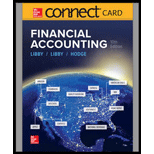
Concept explainers
1. a.
Prepare the
1. a.
Explanation of Solution
Straight-line method:
The depreciation method which assumes that the consumption of economic benefits of long-term asset could be distributed equally throughout the useful life of the asset is referred to as straight-line method.
Formula for straight-line depreciation method:
Depreciation expense:
Depreciation expense is a non-cash expense, which is recorded on the income statement reflecting the consumption of economic benefits of long-term asset.
The total amount of depreciation expense deducted, from the time asset acquired till date, as reported in the account as on a particular date, is referred to as accumulated depreciation.
Formula for accumulated depreciation:
Book value:
The amount of acquisition cost of less accumulated depreciation as on a particular date is referred to as book value.
Formula for book value:
Depreciation schedule under straight-line method:
| Year | Computation | Depreciation Expense | Accumulated Depreciation | Net Book Value |
| At Acquisition | $950,000 | |||
| 1 | $180,000 | $180,000 | 770,000 | |
| 2 | 180,000 | 360,000 | 590,000 | |
| 3 | 180,000 | 540,000 | 410,000 | |
| 4 | 180,000 | 720,000 | 230,000 | |
| 5 | 180,000 | 900,000 | 50,000 |
Table (1)
b.
Prepare the depreciation expense schedule under units-of-production method.
b.
Explanation of Solution
Units-of-production method:
The depreciation method which assumes that the consumption of economic benefits of long-term asset is based on the production capacity or output is referred to as units-of-production method.
Formula for units-of-production depreciation method:
Depreciation schedule under units-of-production method:
| Year | Computation | Depreciation Expense | Accumulated Depreciation | Net Book Value |
| At Acquisition | $950,000 | |||
| 1 | $210,000 | $210,000 | 740,000 | |
| 2 | 201,000 | 411,000 | 539,000 | |
| 3 | 150,000 | 561,000 | 389,000 | |
| 4 | 219,000 | 780,000 | 170,000 | |
| 5 | 120,000 | 900,000 | 50,000 |
Table (2)
c.
Prepare the depreciation expense schedule under double-declining-balance method.
c.
Explanation of Solution
Double-declining-balance method:
The depreciation method which assumes that the consumption of economic benefits of long-term asset is high in the early years but gradually declines towards the end of its useful life is referred to as double-declining-balance method.
Formula for double-declining-balance depreciation method:
Depreciation schedule under double-declining-balance method:
| Year | Computation | Depreciation Expense | Accumulated Depreciation | Net Book Value |
| At Acquisition | $950,000 | |||
| 1 | $380,000 | $380,000 | 570,000 | |
| 2 | 228,000 | 608,000 | 342,000 | |
| 3 | 136,800 | 744,800 | 205,200 | |
| 4 | 82,080 | 826,880 | 123,120 | |
| 5 | 73,120 | 900,000 | 50,000 |
Table (3)
Note: In Year 5, the net book value of the asset cannot be less than the residual value of such asset. Hence, calculate the depreciation expense as given in the working note below.
Working Note:
Compute depreciation expense in Year 5.
2.
Identify the factors which the management might consider in selecting a preferable depreciation method in conformity with the expense principle.
2.
Explanation of Solution
- If there is an equal consumption of asset during the useful life of the asset and if there is a steady decline in its efficiency every year over its useful life, then the management can prefer straight-line depreciation method.
- If there is high consumption of asset in the early years of useful life and decline in usage towards the end of its useful life and if it perform efficiently in their earlier useful life and earn more revenue than in their later years, then the management can prefer double-declining-balance depreciation method.
- If the asset is not used at a uniform rate from period to period and if its efficiency varies from year to year in accordance with the rate of the output, then the management can prefer units-of-production depreciation method, as the depreciation expense would be better matched with the revenue earned under this method.
Want to see more full solutions like this?
Chapter 8 Solutions
Connect Access Card For Financial Accounting
- I need help with question is correct answer and accounting questionarrow_forwardI am looking for the most effective method for solving this financial accounting problem.arrow_forwardDarton Enterprises had total assets of $420,000 and total liabilities of $155,000 at the beginning of the year. If total assets increased by $97,000 during the year, and total liabilities decreased by $42,000, what is the amount of owner's equity at the end of the year? Answerarrow_forward
- Can you help me solve this financial accounting problem using the correct accounting process?arrow_forwardDiscuss the implications of the revenue recognition principle on the reporting of long-term contracts or projects that span multiple accounting periods.arrow_forwardWhat is the number of units transferred to finished goods?arrow_forward

 AccountingAccountingISBN:9781337272094Author:WARREN, Carl S., Reeve, James M., Duchac, Jonathan E.Publisher:Cengage Learning,
AccountingAccountingISBN:9781337272094Author:WARREN, Carl S., Reeve, James M., Duchac, Jonathan E.Publisher:Cengage Learning, Accounting Information SystemsAccountingISBN:9781337619202Author:Hall, James A.Publisher:Cengage Learning,
Accounting Information SystemsAccountingISBN:9781337619202Author:Hall, James A.Publisher:Cengage Learning, Horngren's Cost Accounting: A Managerial Emphasis...AccountingISBN:9780134475585Author:Srikant M. Datar, Madhav V. RajanPublisher:PEARSON
Horngren's Cost Accounting: A Managerial Emphasis...AccountingISBN:9780134475585Author:Srikant M. Datar, Madhav V. RajanPublisher:PEARSON Intermediate AccountingAccountingISBN:9781259722660Author:J. David Spiceland, Mark W. Nelson, Wayne M ThomasPublisher:McGraw-Hill Education
Intermediate AccountingAccountingISBN:9781259722660Author:J. David Spiceland, Mark W. Nelson, Wayne M ThomasPublisher:McGraw-Hill Education Financial and Managerial AccountingAccountingISBN:9781259726705Author:John J Wild, Ken W. Shaw, Barbara Chiappetta Fundamental Accounting PrinciplesPublisher:McGraw-Hill Education
Financial and Managerial AccountingAccountingISBN:9781259726705Author:John J Wild, Ken W. Shaw, Barbara Chiappetta Fundamental Accounting PrinciplesPublisher:McGraw-Hill Education





